|
|||
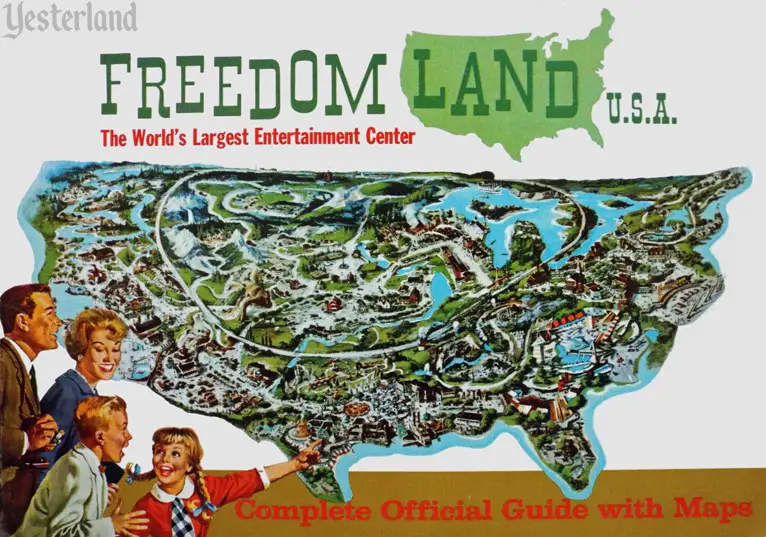
Credit: Michael R. Virgintino Collection |
|||
|
Freedomland U.S.A. opened in The Bronx in June 1960, slightly less than five years after Disneyland opened in Anaheim. The new park was supposed to be the “Disneyland of the East.” In many ways, it was. But after its 1964 operating season, it closed forever. The image above is the cover of Freedomland U.S.A. Complete Official Guide with Maps. This booklet, which cost 25 cents in 1960, contained more than 16 pages of information, along with original color artist concept drawings of many park attractions.
Mike Virgintino, the author of Freedomland U.S.A.: The Definitive History
|
|||
|
|
|||
Remembering Freedomland U.S.A.By Mike VirgintinoImagine helping douse the Great Fire of Old Chicago, riding in a correspondent’s wagon under a flag of truce while dodging cannonballs on a Civil War battlefield and then exploring the Northwest Territory on a bull boat. That’s exactly how kids experienced history with mom and dad, and other family members and friends, when they visited Freedomland U.S.A. The American history theme park was created by C.V. Wood, the same man who brought Walt Disney’s imagination to life in California as Disneyland’s first employee. Baby boomers who grew up east of the Mississippi during the early 1960s will recall the theme park in New York City that featured an entertaining presentation of American history. For most eastern kids, traveling cross-country by train, car, or plane to experience Disneyland never became part of the family plans or the budget. A trip to New York City, though, was more realistic at the time to visit such popular sites as the Empire State Building, the Statue of Liberty, and Yankee Stadium. Then, there was Freedomland U.S.A. After C.V. and Walt contentiously parted ways following the grand opening of Disneyland, Woody created theme parks around the country for investors who clamored to tap into the entertainment success enjoyed by the Disney brothers. Woody created Magic Mountain in Golden, Colorado, and then Pleasure Island in Wakefield, Massachusetts. Freedomland came next and it was followed soon after by Six Flags Over Texas in Arlington. Each of Woody’s parks was created carefully and artistically, with the same detail associated with Disneyland. But each park, except for the one in Texas that continues to operate today, eventually filed for bankruptcy. Though Freedomland has worn the bankruptcy label for more than five decades, the park was not an entertainment nor a financial flop. Freedomland was popular with the masses—but unknown to the public and to Woody, Freedomland was part of a greater scheme to develop the land it occupied in The Bronx. More Than 40 AttractionsStagecoach rides, train robberies, and Wild West shoot-outs brought the popular western television shows of the day to life for guests of Freedomland. Every day was Mardi Gras in the New Orleans themed area of the park, while up north, in Old Chicago, the Great Fire consumed the city several times each day. The park’s four dark rides, among other attractions, incorporated the technical advances of the day. Those dark rides—the recreation of the San Francisco Earthquake, a deep down trip into a mine cave, a jolly time with buccaneers and a lifelike experience of spinning in a tornado—and several other attractions at Freedomland were created by Arrow Development of Mountain View, California. The company was well known to Woody, as were other Disneyland vendors and sponsors that became associated with Freedomland. Arrow, specifically, had worked on a number of attractions for the opening of Disneyland: Mad Tea Party, King Arthur Carrousel, Mr. Toad’s Wild Ride, Dumbo Flying Elephants, Casey Jr. Circus Train, and Snow White’s Adventures. Millions of guests during Freedomland’s five seasons (1960-1964) journeyed to The Bronx from New York City neighborhoods and from all over the east coast as far west as Ohio and Missouri. A handful of lucky children from California also enjoyed the park. They all were part of family day trips and vacations, scout outings, hometown newspaper events for newsboys and newsgirls, and bus tours organized by little leagues, department stores, schools, churches, and community groups. While Freedomland was short-lived, memories of the fun and excitement at the park continue to remain fresh for America’s boomers. I am one of those kids who first experienced American history, in an entertaining way, at Freedomland. |
|||
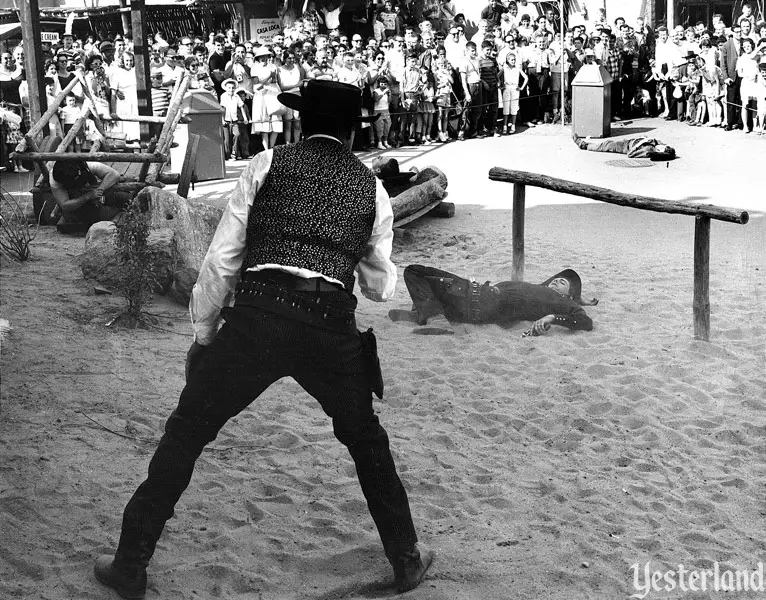
Credit: Billy Collins Everyone in the park gathered for the Wild West shoot-outs. The marshal always secured the peace. |
|||
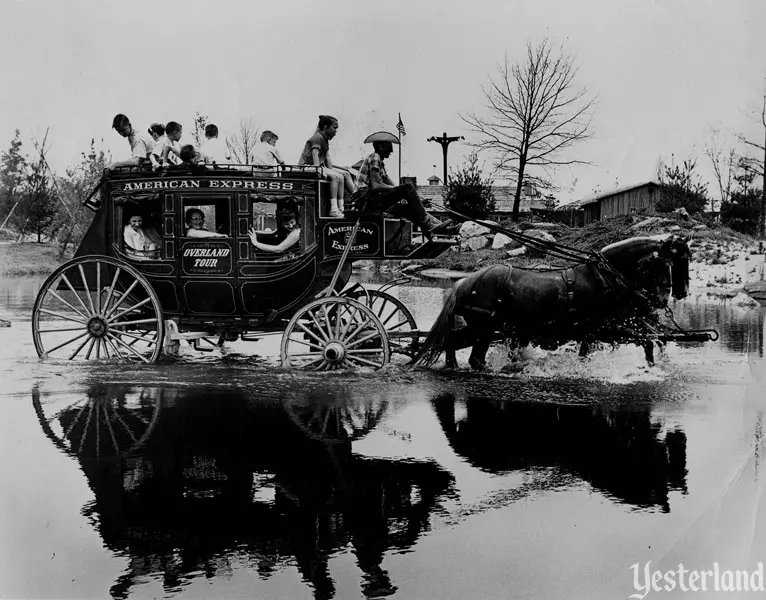
Credit: Billy Collins The western stagecoach took passengers past buffaloes and steers but also encountered desperados along the way. It was sponsored by American Express. |
|||
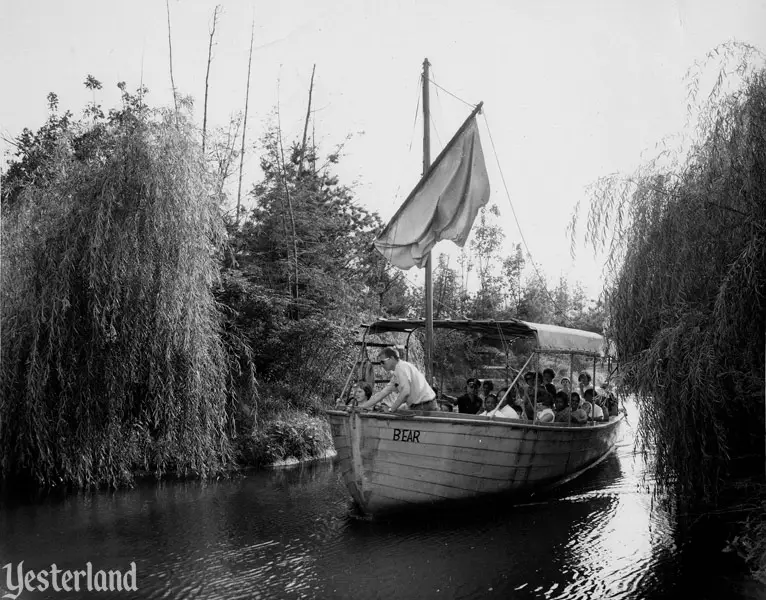
Credit: Billy Collins A bull boat similar to those used by Lewis and Clark brought park guests through the untamed wilderness of the Pacific Northwest where they would see wild animals and get caught in the crossfire between trappers and Native Americans. |
|||
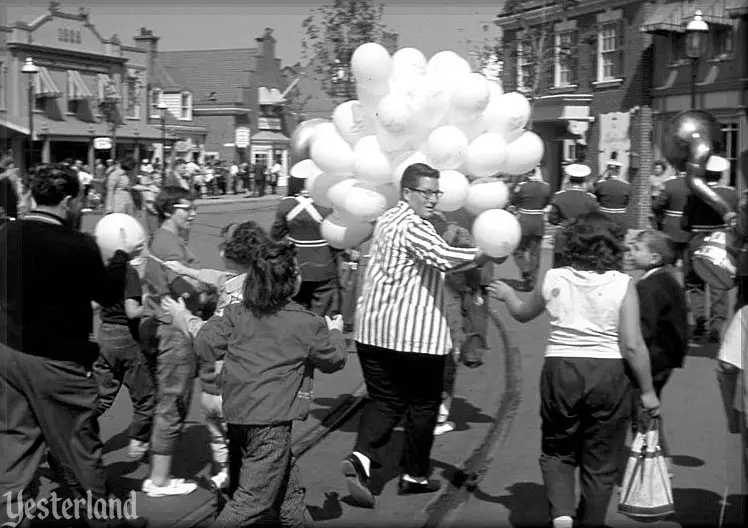
Credit: Neil Borrell Neil Borrell enjoyed working at Freedomland during 1962 prior to his senior year in high school. He was employed directly by American Oil Company (Amoco), working at the company’s travel exhibit in Little Old New York. He sometimes inflated balloons and also walked the streets handing balloons to park guests. Eventually, he marched at the end of the twice-daily parade and handed balloons to kids. The Amoco exhibit also included Amoco Sam, a talking gas pump that memorized kids. Neil sometimes was the “voice” of the Amoco Sam. |
|||
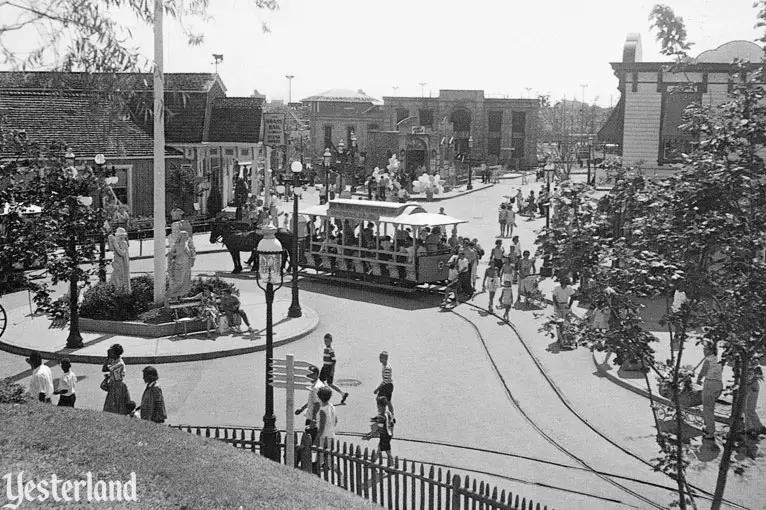
Credit: Michael R. Virgintino Collection Old Chicago of 1871 featured one of the park’s two train stations with vintage trains, horse-drawn trolleys that traveled from Little Old New York, the Chicago Fire attraction seen in the distance, two sternwheelers, other attractions and a Hallmark store. |
|||
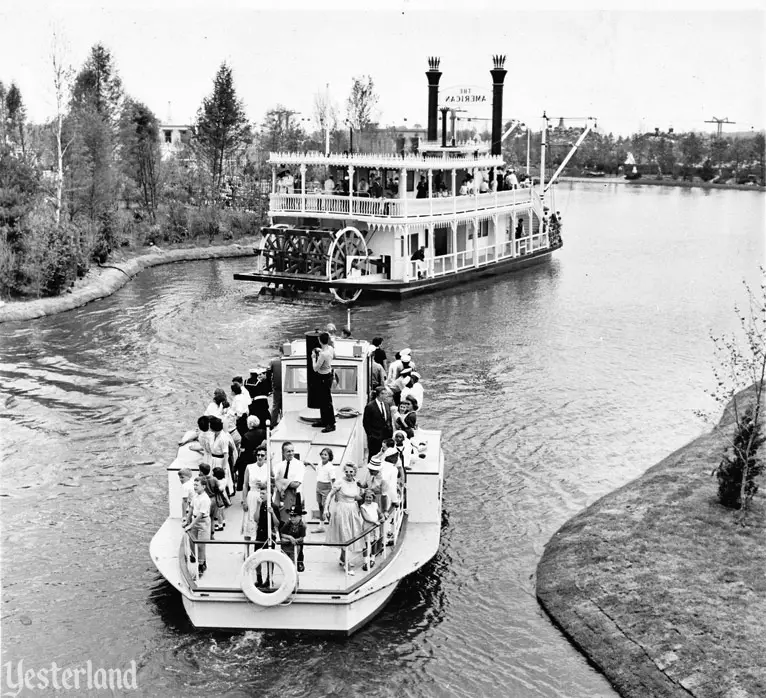
Credit: Michael R. Virgintino Collection Sternwheelers and tug boats traveled along Freedomland’s version of the Great Lakes. Two sternwheelers (“The American” and “The Canadian”) were docked at the park’s Old Chicago themed area while the tug boats (“Totsie” and “Pert”), built to recreate the New York City tugs of the late 1800s, were located in the Little Old New York themed section. |
|||
Bronx RaisedMy parents were raised in the South Bronx. When my father returned from World War II, they married and purchased a new brick row house, budgeting $16,000 for a home on a quiet side street in the northeast section of the borough. That was a lot of money during 1951! I came along a few years later. Then, Freedomland U.S.A. appeared on marshland in the nearby valley. To this day, people in this part of New York City still refer to the area as the valley. Summers at Freedomland captured my imagination and nurtured my love for history. My passion about our past has grown stronger with each passing year since Freedomland closed its gates. I have met many other men and women over the years who can trace their interest in American history to the theme park in The Bronx. For the last 40-plus years, as a journalist and public relations / marketing executive, I have written and spoken about a variety of topics. The conversations and articles frequently incorporate some aspect of our history, because during all these years I have cherished many fond memories of that wonderful theme park in the neighborhood of my youth.
More than 10 years ago, I realized that I needed to “return” to Freedomland. After writing several magazine and online articles about the park, I created a popular memory page on Facebook (Freedomland U.S.A.—The World’s Largest Entertainment Center) that also has incorporated Twitter and Instagram. Now, in a new book, Freedomland U.S.A.: The Definitive History America’s Theme ParkFreedomland U.S.A., which is celebrating its 60th anniversary during 2020, was much different than conventional amusement parks. It was a theme park that featured the story of America through attractions in its seven themed areas—Little Old New York of the late 1800s; Old Chicago of the 1871 fire and vintage steam trains; The Great Plains, with its fort and a farm sponsored by Borden that featured Elsie the Cow; San Francisco of 1907 with Fisherman’s Wharf, the Barbary Coast, the famous earthquake, and a boat trip through Lewis and Clark territory; The Old Southwest with its saloon, western stage shows, and mine caverns; New Orleans with carnival celebrations and the centennial commemoration of our Civil War; and Satellite City, which embraced the present and future space race. The research and design team that created and constructed Freedomland consisted of about 200 leading artists and architects. Some were former Disney employees known to Woody. Others were veterans of the film industry, television, and Broadway. The Bronx location for the theme park was a 205-acre site at the southern part of about 400 acres of marshland. The park and its attractions were located on 85 acres (Disneyland originally occupied 65 acres), with the remaining 120 acres reserved for maintenance facilities and parking. Freedomland’s grand opening had been scheduled for June 1, 1960. It then was rescheduled for a month later to ensure that the park would be ready for the anticipated crowds. Due to the growing excitement generated by aggressive advertising, marketing and the on-air promotion by the city’s popular music radio stations, the official opening date again changed to June, specifically to Father’s Day on Sunday, June 19.
Mommy & Daddy, take my hand Unfortunately, Freedomland did not last. When it closed following the 1964 season, management publicly cited competition from the New York World’s Fair, which had opened that same year and continued through 1965. The truth began to emerge only many years later. Competition from the Fair did not seal the fate for Freedomland. The Fair, however, did become a convenient public excuse as the park was maneuvered into bankruptcy court. Unknown to the general public—and unknown to C.V. Wood and his design team that had moved on to develop other venues—Freedomland was used as a “placeholder” for the property by the landowner, city planners, politicians, and others to obtain the necessary clearances to build the world’s largest cooperative housing project on the marshland. |
|||
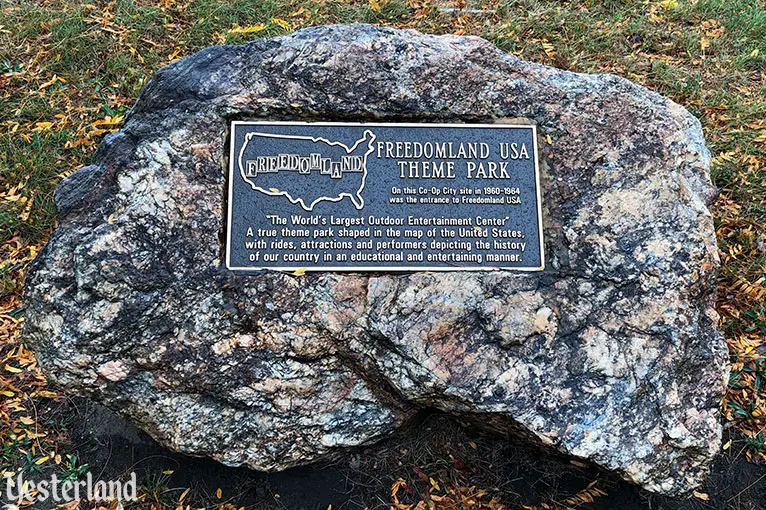
Photo by Hugo L. González, 2017 (CC BY-SA 4.0) (modified) Commemorative plaque at the site that was once the park entrance |
|||
|
That residential community, known as Co-op City, recently celebrated its 50th anniversary. Baby boomers, though, still refer to this area of The Bronx as Freedomland. |
|||
About Mike VirgintinoMichael R. Virgintino is a marketing communications executive who began his career in the newsrooms of New York City area radio stations. He has directed corporate, nonprofit, and product-branding initiatives that rely on public relations, public affairs, corporate social responsibility, community relations, and related strategies. He also is an historian who writes about the American Revolution, the Civil War, and other topics, and he has, over the years, offered his communications capabilities to support the preservation of American history and historical sites across the country. He grew up in the shadow of Freedomland and created the popular Freedomland Facebook memory page several years ago. |
|||
About the BookFreedomland U.S.A.: The Definitive History, published by Theme Park Press, is available from Amazon and other online retailers. For more information, click on the book cover below. |
|||
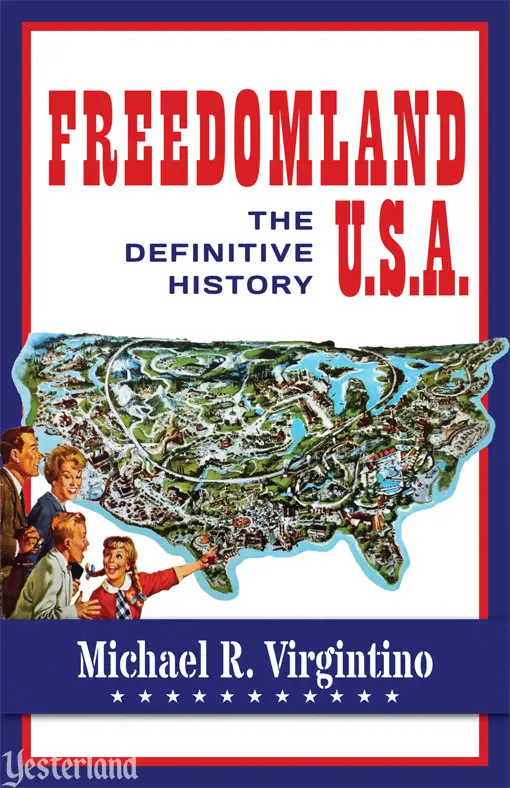 Credit: Michael R. Virgintino and Theme Park Press |
|||
|
|||
|
Yesterland is a participant in the Amazon Services LLC Associates Program, an affiliate advertising program designed to provide a means for sites to earn advertising fees by advertising and linking to Amazon. That means Yesterland benefits financially if you buy this book (and any other items at Amazon) using a link in this article. |
|||
|
|
Click here to post comments at MiceChat about this article.
© 2020 Werner Weiss — Disclaimers, Copyright, and Trademarks Updated April 17, 2020. |
||